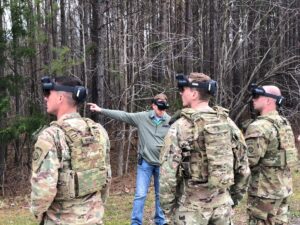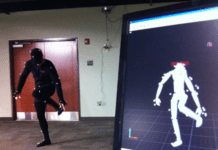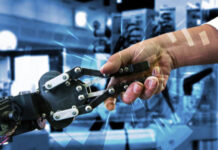As an industry expert with more than 10 years of experience in the field of emerging technologies, I have seen firsthand how artificial intelligence (AI), chatbots, and augmented reality/virtual reality (AR/VR) have transformed the way businesses operate. The potential applications of these technologies in the enterprise are limitless, and I am excited to share my insights on how they can be leveraged for greater efficiency, productivity, and profitability.
AI has the power to automate repetitive tasks, improve decision-making, and enhance customer experiences. In the enterprise, AI can be used to analyze vast amounts of data to uncover patterns, trends, and insights that humans may miss. It can also be used to automate routine tasks, such as data entry, customer service, and inventory management, freeing up employees to focus on more complex and creative work. Chatbots, which use natural language processing and machine learning to simulate human conversations, can also be used to improve customer service by providing 24/7 support, answering frequently asked questions, and guiding customers through the sales process.
AR/VR technologies will enhance the way employees work and learn by providing immersive, interactive experiences. In manufacturing, for example, workers can use AR glasses to overlay instructions and digital models onto physical machinery, making it easier to assemble, repair, and maintain equipment. In training, AR/VR can simulate real-world scenarios, allowing employees to practice new skills and procedures in a safe and controlled environment. In sales and marketing, AR/VR can be used to create interactive product demos, virtual showrooms, and immersive brand experiences that engage and delight customers.

One of the most promising areas is telemedicine, where patients can connect with doctors remotely using AR/VR technology. This could be particularly useful in areas with limited medical infrastructure or in emergency situations where medical assistance is required immediately.
AI-powered chatbots can be used to provide personalized health advice, monitor patient vitals, and help with medication management. These chatbots can use natural language processing to understand patients’ symptoms and provide appropriate guidance.
AR and VR can be used for training medical students and practicing doctors. Medical students can use these technologies to simulate surgeries, practice on virtual patients, and learn anatomy in a more interactive way. Practicing doctors can use AR/VR to get a better understanding of complex medical cases, allowing them to make more informed decisions.
Another promising use case is the development of personalized medicine. AI can be used to analyze large amounts of patient data to identify patterns and develop individualized treatment plans. This can lead to more effective treatments and better patient outcomes.
AI, chatbots, AR and VR will also be used for medical research and drug discovery. AI is already being used to analyze large amounts of data to identify new treatments or potential drug interactions. Chatbots will then be used to collect patient data for research studies. AR and VR are then used to simulate drug interactions and test new treatments before they are used on human subjects.
The retail industry is constantly evolving, and advancements in AI, chatbots, AR, and VR are transforming the shopping experience for consumers. One potential use case for these technologies is in the area of personalized shopping. With the help of AI and chatbots, retailers can provide personalized recommendations to customers based on their shopping history and preferences. This can increase customer satisfaction and loyalty, as well as drive sales.
AR and VR can also enhance the in-store shopping experience by allowing customers to visualize products in a more immersive way. For example, a furniture retailer can use AR to show customers how a particular piece of furniture would look in their home before making a purchase. This can reduce the chances of returns and increase customer confidence in their purchase decisions.

Another potential use case for these technologies is in the area of supply chain management. AI and chatbots can help retailers manage inventory more effectively, predicting demand and ensuring that products are in stock when customers need them. AR and VR can also be used to train employees in areas such as inventory management and customer service.

The use of technology in military training is not a new concept, but recent advancements in AI, chatbots, AR, and VR are transforming the way training is delivered. These technologies provide the military with the ability to simulate various combat scenarios and create more immersive training environments that help to enhance the skills of service members.
AI-powered chatbots can serve as virtual mentors and provide personalized training to soldiers. They can assist with language learning, help soldiers practice tactical decision-making, and provide feedback on performance. These chatbots can also be used for remote training, allowing soldiers to receive training no matter where they are stationed.
AR and VR technologies can create virtual environments that simulate real-world scenarios, such as combat or emergency situations. Soldiers can train in these environments without the risks associated with live training exercises. AR and VR can also provide detailed information about weapons, equipment, and vehicles, allowing soldiers to familiarize themselves with these items before encountering them in the field.
In addition, AR and VR technologies can also be used to provide medical training to soldiers. Virtual reality simulations can allow soldiers to practice treating injuries and performing medical procedures in a safe and controlled environment.
Finally, and one of my favorite examples is that AI, chatbots, and AR/VR have enormous potential to revolutionize K-12 education. In math and foreign language instruction, AI-powered chatbots can provide personalized, interactive learning experiences for students. They can answer questions, provide feedback, and adapt to the individual needs of each student. AR/VR can enhance learning in history and social studies by bringing historical events to life and allowing students to experience them firsthand. In financial literacy, virtual simulations can help students understand the real-world implications of financial decisions. Additionally, AI-powered chatbots can provide guidance on budgeting, saving, and investing.
In the realm of civics education, the United States Constitution can be made more accessible to students through AR/VR. By using AR/VR, students can immerse themselves in historical events and gain a better understanding of the constitution and its significance. For example, students can use AR/VR to explore the different branches of government or take a virtual tour of the US Capitol.
https://www.pwc.com/us/en/services/consulting/technology/emerging-technology/assets/pwc-understanding-the-effectiveness-of-soft-skills-training-in-the-enterprise-a-study.pdf
One of the most exciting developments in this space is the emergence of ChatGPT, a language model that uses deep learning to generate human-like responses to text-based queries. ChatGPT has the potential to revolutionize the way businesses interact with customers and employees by providing personalized, conversational support at scale. By integrating ChatGPT with AI-powered chatbots, businesses can provide a seamless, end-to-end experience that meets the needs of today’s digitally savvy customers.
One of the most exciting prospects of integrating AI and ChatGPT with AR/VR is the ability to create more immersive and personalized experiences. For example, imagine a virtual training session where an AI-powered virtual assistant can answer trainees’ questions in real-time or a medical simulation where ChatGPT can provide patients with personalized instructions for their care. These applications not only enhance the user experience but also increase the efficacy of AR/VR solutions.
Additionally, AI and ChatGPT can help address some of the technical challenges associated with AR/VR, such as natural language processing and voice recognition. This can lead to more seamless and intuitive interactions with AR/VR systems, making them more accessible to a wider range of users.
However, the integration of AI, ChatGPT, and AR/VR also presents challenges that must be addressed. One such challenge is ensuring the ethical use of AI and data privacy in AR/VR experiences. As AR/VR technologies become more sophisticated, it becomes increasingly important to consider how data is collected, stored, and used to ensure that it is done so in a responsible and ethical manner.
Another challenge is the potential for AI and ChatGPT to perpetuate bias and discrimination. This can occur if the data sets used to train these systems are not diverse and representative. As a result, it is essential to develop and implement best practices to ensure that AI and ChatGPT are trained on diverse and inclusive data sets to minimize bias and discrimination in AR/VR experiences.
In conclusion, the integration of AI, ChatGPT, and AR/VR presents exciting opportunities for creating more immersive and personalized experiences while also addressing technical challenges. However, it is essential to consider the ethical and diversity implications of these technologies to ensure that they are used responsibly and inclusively. As an industry expert, I am excited to see how these technologies will continue to evolve and shape the future of AR/VR.























